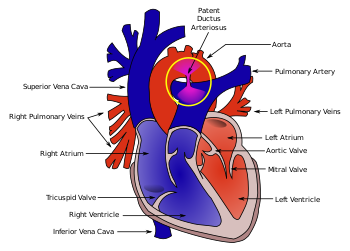User:Mr. Ibrahem/Patent ductus arteriosus
| Patent ductus arteriosus | |
|---|---|
| Other names | Persistent ductus arteriosus |
 | |
| Diagram of a cross-section through a heart with PDA | |
| Specialty | Cardiac surgery, paediatrics |
| Symptoms | Shortness of breath, decreased ability to exercise[1] |
| Complications | Heart failure, necrotizing enterocolitis, kidney failure, intraventricular hemorrhage[2] |
| Usual onset | Present at birth[3] |
| Types | Type A to E[2] |
| Causes | Unknown[1] |
| Risk factors | Preterm birth, maternal diabetes, cocaine, calcium channel blockers, birth at high elevation, genetic syndromes[2] |
| Diagnostic method | Suspected based on a heart murmur, confirmed by ultrasound of the heart[2] |
| Differential diagnosis | Total anomalous pulmonary venous return, persistent truncus arteriosus, pulmonary arteriovenous fistula[2] |
| Treatment | Watchful waiting, NSAIDs, surgery[2] |
| Prognosis | Generally good[2] |
| Frequency | Relatively common[3] |
Patent ductus arteriosus (PDA) is when the connection between the aorta and pulmonary artery (the ductus arteriosus) fails to close after birth.[3] Early on there are generally no symptoms; however, later shortness of breath, failure to gain weight at a normal rate, or difficulty exercising may occur.[1][4] Complications may include heart failure, pulmonary hypertension, necrotizing enterocolitis, kidney failure, and intraventricular hemorrhage.[2]
The cause is generally unknown.[1] Risk factors include premature birth, maternal diabetes, cocaine, calcium channel blockers, and birth at high elevation.[2] It is associated with a number of genetic syndromes including trisomy 13, Down syndrome, and DiGeorge syndrome.[2] The ductus arteriosus is a fetal blood vessel that normally closes within 24 to 48 hours after birth.[2] The diagnosis may be suspected based on a continuous heart murmur and confirmed by ultrasound of the heart.[2]
Treatment may be recommended in those with symptoms.[2] This may include the use of NSAIDs such as ibuprofen or surgery.[2] Otherwise if it does not close on its own within 8 weeks treatment is recommended.[2] Outcomes are generally good.[2]
While common overall, it is rare in full term otherwise healthy babies.[3][2] In those weighing less than 1 kilogram at birth, 70% are affected at 7 days.[2] It is also present in 10% of people with other congenital heart disorders.[2] The ductus arteriosus was first described in the 100s AD by Galen.[5] Surgical treatment was first carried out in 1938.[6]
References[edit]
- ^ a b c d Ho, Vincent; Reddy, Gautham P. (2010). Cardiovascular Imaging E-Book. Elsevier Health Sciences. p. 583. ISBN 978-1-4557-0697-6.
- ^ a b c d e f g h i j k l m n o p q r s Gillam-Krakauer, M; Mahajan, K (January 2020). "Patent Ductus Arteriosus". PMID 28613509.
{{cite journal}}: Cite journal requires|journal=(help) - ^ a b c d "Congenital Heart Defects | NHLBI, NIH". www.nhlbi.nih.gov. Retrieved 7 February 2021.
- ^ "Patent Ductus Arteriosus - Children's Health Issues". Merck Manuals Consumer Version. Retrieved 7 February 2021.
- ^ Sebastian, Anton (2018). A Dictionary of the History of Medicine. Routledge. p. PT641. ISBN 978-1-351-46999-9.
- ^ Satpathy, M. (2015). Clinical Diagnosis of Congenital Heart Disease. JP Medical Ltd. p. 116. ISBN 978-93-5152-912-5.
